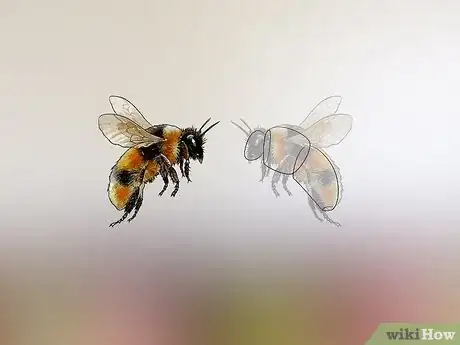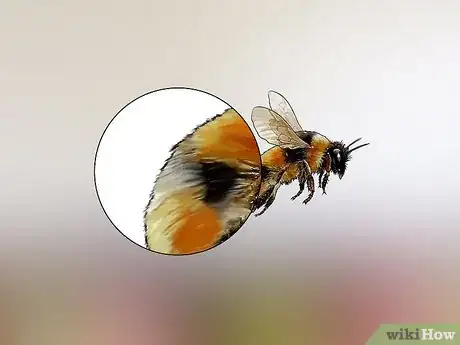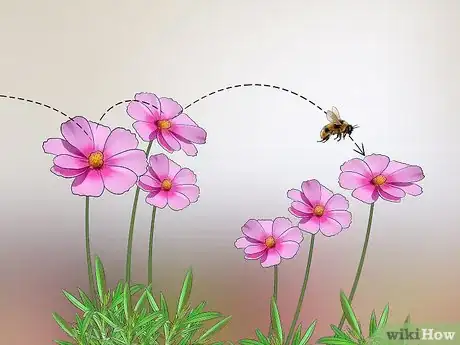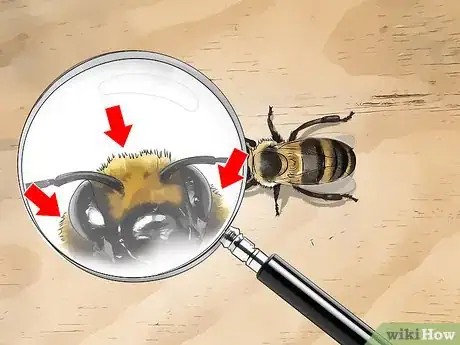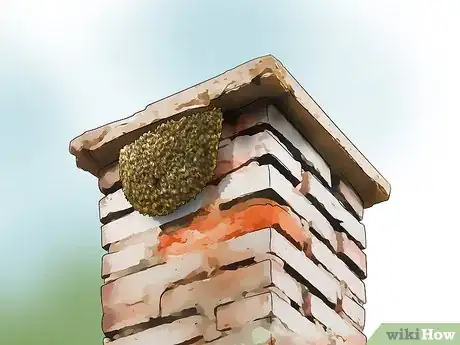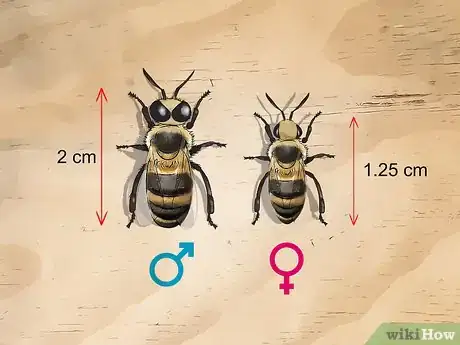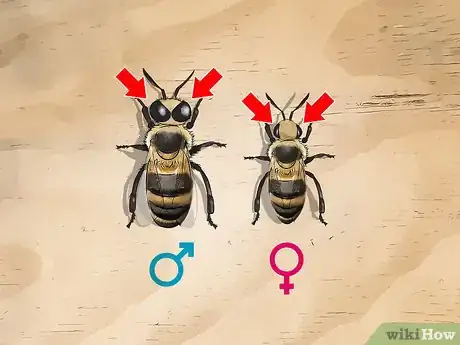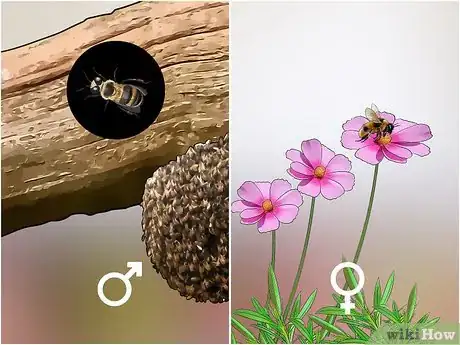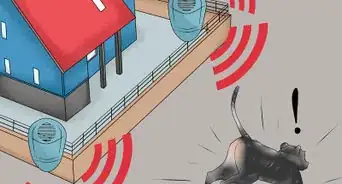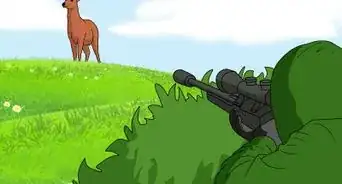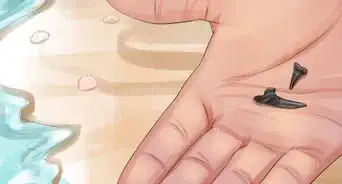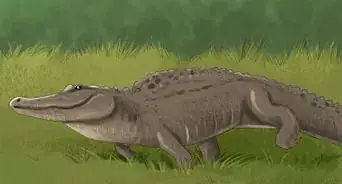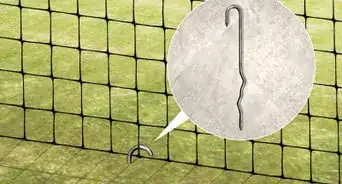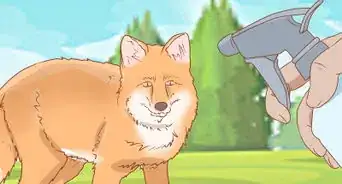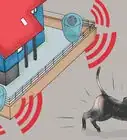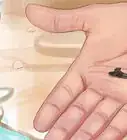This article was co-authored by David Williams. David Williams is a Professional Beekeeper and Bee Removal Specialist with over 28 years of beekeeping experience. He is the Owner of Bzz Bee Removal, a bee removal company based in the San Francisco Bay Area. Bzz Bee Removal locates, captures, and transports bees to local beekeepers to prevent colony collapse disorder.
This article has been viewed 86,463 times.
Honey bees are very important insects that pollinate flowers and plants of all different varieties. Unlike wasps, they normally stay away from humans unless defending their nest, and they have a very vital role in the ecosystem. It's easy to tell the difference between honey bees, other types of bees, and wasps in nature, as well as differentiate between male and female bees!
Steps
Spotting a Honey Bee
-
1Identify the body shape of the insect. The easiest way to differentiate a honey bee from other types of bees or wasps is to look at the shape of their thorax and abdomen. Honey bees have a distinctive barrel-shaped body and don't have a thin middle section between the thorax and abdomen like other insects.[1]
- Wasps tend to have a very thin middle section and distinct thorax and abdomen. Honey bees have a thorax and abdomen that look like one complete piece.
-
2Look for hair on the body and head. Honey bees are generally covered in small hairs that make them look fuzzy all over. Honey bees, unlike bumble bees, tend to have shorter hairs that are only visible when looking at them up close.[2]
- These tiny hairs are how the honey bee gathers pollen and transports it to other flowers, so the hair is very important for the survival of the bee!
Advertisement -
3Follow the bee's flight path to tell the difference between bees and wasps. Honey bees are pollinators and will be flying between flowers and their nest to provide pollen and nectar to the colony. Wasps are carnivores, and will be travelling to locations where there are other insects to eat.
- Wasps and other carnivorous insects will also be attracted to human food, like your picnic. Honey bees normally won't come around human food but may be attracted by nearby flowers or other sweet scents. As such, you can take a number of steps to keep away from bees and wasps when you're eating outside.
- Other bees, such as orchid bees, will also fly between flowers to pollinate. This method is only good for differentiating between bees and wasps.
-
4Use a magnifying glass to look at the eyes. Honey bees have hairy eyes to collect pollen from flowers and transport it over long distances. Honey bees will have two larger eyes on either side of their head, and then three small eyes in a triangle shape in the center of the head, which is a distinguishing trait of honey bees.[3]
- Male and female honey bees have eyes that are slightly different sizes and shapes, but they are both still hairy.
-
5Search for a nest inside hollow trees and other protected structures. Honey bee nests are easy to spot because they have the distinctive “honeycomb” structure in either white or yellow color. They won't build nests hanging from tree branches, like other types of bees, because the nest and honey would be unprotected. Instead, look inside of hollow trees or manmade structures.
- Honey bees will never make a nest in the ground. If you see insects have nested in holes, they are likely Yellow Jacket wasps, which are very dangerous and can sting.
- Honey bee nests never have a protective or paper-like coating around them. They are open to the air and can appear shiny due to the nectar and honey being produced.
Telling the Difference Between Male and Female
-
1Measure the size of the bee. Male honey bees tend to be around 2 centimetres (0.79 in) long, which is slightly larger than female honey bees, which are normally 1.25 centimetres (0.49 in). The small size of the female bees, which are also known as worker bees, allow them to move quickly from flower to flower to pollinate and collect food for the nest.
- Males tend to have bodies that are more rounded than females, making them less agile while in flight.
- The largest honey bee in the colony is the female queen bee, but it will only emerge from the nest when it's time to swarm. It's very unlikely that you will spot a queen bee outside of the nest!
-
2Use a magnifying glass to carefully inspect the eyes of the bee. Female honey bees have smaller eyes on either side of their head that are proportional to their bodies. Male bees have very large eyes that make it easier for them to spot the queen as she is moving about.[4]
- The female bee's small, separated eyes help to locate flowers and plants to pollinate while in flight.
- The male bee's eyes will appear to touch at the top of the head, giving them a circular shape.
-
3Make note of where you found the bee in relation to the location of the nest. Most honey bees seen pollinating are female worker bees. The large male, or drone, bees can normally be found in the area near the nest. Male bees won't venture too far from the location of the nest and the queen bee.
- Male bees will sometimes fly away from the nest in large groups to mate with other queens.
Expert Q&A
-
QuestionHow can you tell honey bees from carpenter bees?
 David WilliamsDavid Williams is a Professional Beekeeper and Bee Removal Specialist with over 28 years of beekeeping experience. He is the Owner of Bzz Bee Removal, a bee removal company based in the San Francisco Bay Area. Bzz Bee Removal locates, captures, and transports bees to local beekeepers to prevent colony collapse disorder.
David WilliamsDavid Williams is a Professional Beekeeper and Bee Removal Specialist with over 28 years of beekeeping experience. He is the Owner of Bzz Bee Removal, a bee removal company based in the San Francisco Bay Area. Bzz Bee Removal locates, captures, and transports bees to local beekeepers to prevent colony collapse disorder.
Beekeeper & Bee Removal Specialist If you see pencil-sized holes, piles of sawdust near wood in your home, or bees near your eaves, you may be dealing with carpenter bees instead.
If you see pencil-sized holes, piles of sawdust near wood in your home, or bees near your eaves, you may be dealing with carpenter bees instead. -
QuestionAre honey bees aggressive?
 CanisChiropteraCommunity AnswerUnless they feel that their hive is in danger, not at all. If a bee stings you, it will die, so it will only do so if absolutely necessary. Leave them alone and they'll leave you alone!
CanisChiropteraCommunity AnswerUnless they feel that their hive is in danger, not at all. If a bee stings you, it will die, so it will only do so if absolutely necessary. Leave them alone and they'll leave you alone! -
QuestionI have a hive above the door of our house. How long will the bees stay at the hive?
 Gabriella CalderonCommunity AnswerThe hive will remain there until something disturbs the hive or the bees are killed. If you plan to remove the bees yourself, only do so at night. The bees will not leave the hive at night because they would not be able to make it back. You might want to check out the article How to Get Rid of Bees, as there is info in there about how to get the hive moved without having to kill the bees.
Gabriella CalderonCommunity AnswerThe hive will remain there until something disturbs the hive or the bees are killed. If you plan to remove the bees yourself, only do so at night. The bees will not leave the hive at night because they would not be able to make it back. You might want to check out the article How to Get Rid of Bees, as there is info in there about how to get the hive moved without having to kill the bees.
Warnings
- While honey bees tend to shy away from humans, the female worker bees will defend their nest by stinging if needed. Always wear protective gear when working with honey bees.⧼thumbs_response⧽
References
About This Article
To identify a honey bee, look for an insect with a barrel-shaped body and short, fuzzy hair. They'll usually nest either in trees or other hollow spaces. Unlike wasps and other insects, bees won't have a thin middle section between their thorax and abdomen. Besides its physical appearance, you can identify a honey bee by watching where it goes. For example, wasps will likely be flying towards locations where there are other insects while honey bees will simply be flying from flower to flower to pollinate. If you spot a bee nest, it’s likely a honey bee nest if it’s white or yellow in color and has a distinctive honeycomb structure. To learn how to tell the difference between a male and female honeybee, read on!
